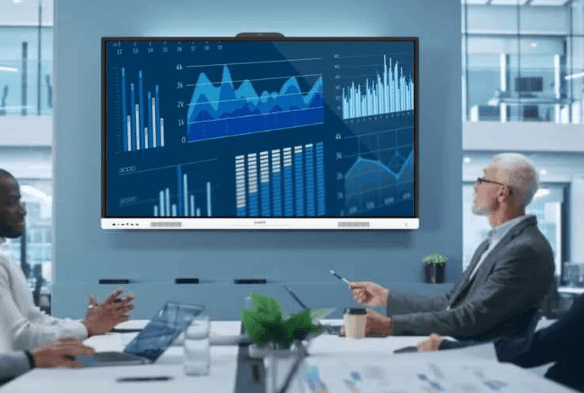Why Interactive Flat Panel Displays Are a Cost-Effective Investment for School districts?

Investing in technology for education is no longer a luxury—it’s a necessity. As schools strive to prepare students for the digital age, interactive flat panel displays (IFPDs) have emerged as one of the most valuable tools in modern classrooms. These interactive displays combine the functionality of a whiteboard, computer, and projector into one versatile device, revolutionizing the way teachers deliver lessons and students engage with content. But beyond their educational benefits, interactive flat panel display are also a cost-effective investment for school districts. Here’s why IFPDs are not just enhancing education but also offering significant value for money.
The Financial Challenges of School Districts
School districts are often faced with tight budgets and must make strategic decisions about where to allocate funds. Balancing the need for advanced educational tools with financial constraints can be a daunting task. Traditional technology investments, such as projectors, whiteboards, and computers, come with hidden costs like maintenance, frequent replacements, and ongoing software updates, which can strain already limited resources.
Interactive flat panel displays offer a long-term, cost-effective solution that addresses these challenges. By consolidating multiple technologies into a single, durable device, IFPDs reduce overall expenses and provide a high return on investment. Here are the key reasons why interactive flat panel displays are a smart financial choice for school districts.
See also: Exploring Out-of-Home Advertising: Inspiring Examples and Innovative Approaches
1. Reduced Maintenance and Replacement Costs
One of the most significant cost-saving benefits of interactive flat panel displays is their durability and low maintenance requirements. Traditional classroom technologies like projectors and interactive whiteboards often require frequent maintenance, including bulb replacements, recalibrations, and repairs. These ongoing costs add up quickly, especially when multiplied across multiple classrooms.
Interactive flat panels, on the other hand, are built to last with robust designs and advanced technology that requires minimal upkeep. They use LED technology that doesn’t need replacement bulbs and are designed to withstand the daily wear and tear of classroom use. Many panels come with protective glass and anti-glare coatings, making them resistant to scratches and smudges. This durability translates to fewer disruptions in learning and significantly lower maintenance costs over time.
2. All-in-One Solution Reducing the Need for Multiple Devices
Interactive flat panel displays serve as an all-in-one solution, consolidating several classroom technologies into one device. With a single IFPD, schools can replace traditional whiteboards, projectors, and speakers, simplifying the classroom setup and reducing the need for additional equipment. This consolidation not only saves money on purchasing multiple devices but also reduces the associated costs of managing and maintaining these tools.
For instance, a classroom with an interactive flat panel does not need a separate projector or interactive whiteboard, eliminating the need for costly projector bulbs, cables, and calibration tools. The IFPD’s built-in speakers and high-resolution display also eliminate the need for additional audio-visual equipment, further cutting costs. By investing in interactive flat panels, school districts can streamline their technology investments and reduce overall expenditures.
3. Energy Efficiency Leading to Lower Operating Costs
Interactive flat panel displays are designed with energy efficiency in mind, using significantly less power than traditional projectors or other classroom technologies. Projectors, in particular, are notorious for their high energy consumption and heat output, which can drive up electricity costs and strain cooling systems.
IFPDs use LED technology that consumes less power and generates less heat, resulting in lower energy bills. Over time, the energy savings from using interactive flat panels can be substantial, especially in large school districts with multiple classrooms. This energy efficiency not only reduces operating costs but also aligns with schools’ sustainability goals, making IFPDs a greener choice for modern classrooms.
4. Extended Lifespan and Warranty Support
Interactive flat panels are designed to provide long-term use with minimal performance degradation. Many models come with extended warranties and support services, ensuring that school districts receive maximum value from their investment. These warranties often cover repairs and replacements, reducing the financial burden on schools when issues arise.
In contrast, projectors and other traditional classroom tools typically have shorter lifespans and limited warranty coverage, leading to more frequent replacements and higher costs over time. By investing in interactive flat panels with extended support, school districts can benefit from reliable technology that lasts longer, reducing the need for frequent reinvestments in new equipment.
5. Enhanced Student Engagement Leading to Improved Learning Outcomes
While the financial benefits are clear, it’s important to consider the broader impact of interactive flat panels on student learning. IFPDs enhance lesson delivery with interactive, engaging content that captures students’ attention and improves comprehension. Studies have shown that technology-rich environments foster higher levels of student engagement, leading to better academic outcomes.
When students perform better, schools can achieve higher test scores, improved graduation rates, and enhanced student satisfaction—all factors that contribute to the overall success of a school district. Investing in technology that boosts student achievement is, in essence, investing in the future of the district. The improved outcomes driven by interactive flat panels justify the initial investment, offering long-term educational and financial benefits.
Real-World Examples: Cost Savings in Action
Many school districts have already reaped the benefits of interactive flat panels as a cost-effective investment. For instance, a district in Texas replaced aging projectors and interactive whiteboards with interactive flat panels across its elementary schools. The district reported a 40% reduction in maintenance costs within the first year and noted significant improvements in student engagement and teacher satisfaction.
Similarly, a school district in California equipped its classrooms with IFPDs and experienced a substantial decrease in technology replacement rates. Teachers reported that the panels made lesson delivery more efficient, and the reduced need for ongoing maintenance freed up budget resources for other educational initiatives.
Conclusion: A Strategic Investment for Modern Education
Interactive flat panel displays are more than just a technological upgrade; they are a strategic investment that offers substantial cost savings and educational benefits. By reducing maintenance and replacement costs, consolidating multiple classroom technologies, and enhancing energy efficiency, IFPDs provide school districts with a financially sound solution that meets the demands of 21st-century education.
For school districts facing budget constraints but striving to provide high-quality education, interactive flat panels are an ideal choice. They not only improve the teaching and learning experience but also deliver a high return on investment, making them the perfect fit for schools looking to make a smart, future-focused decision. Investing in interactive flat panels is not just about technology—it’s about creating a sustainable, engaging, and cost-effective learning environment for all students.





